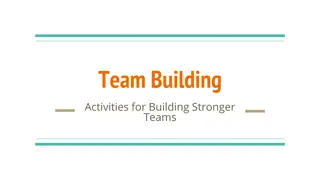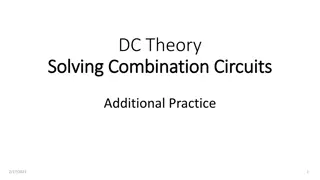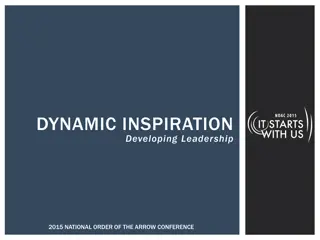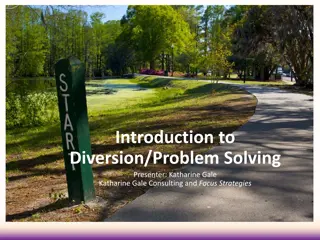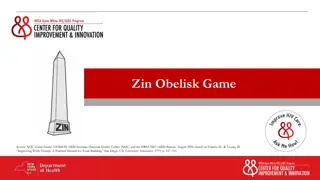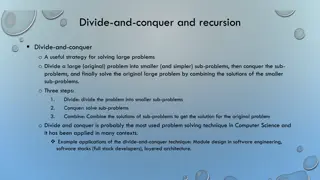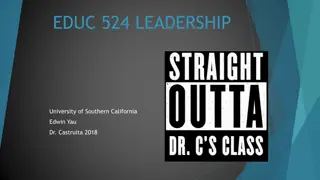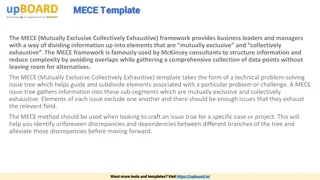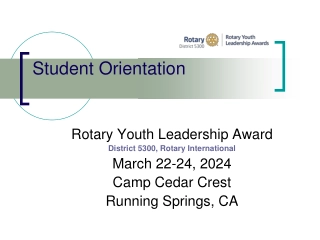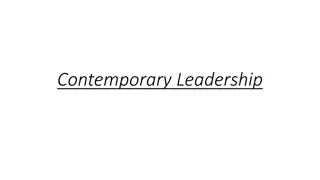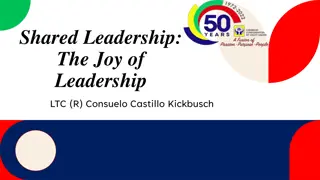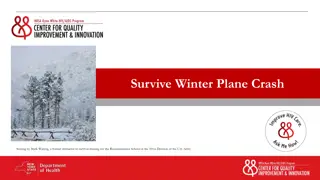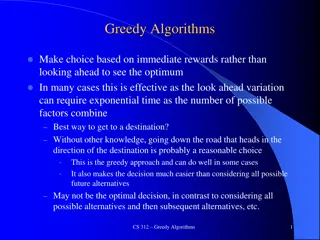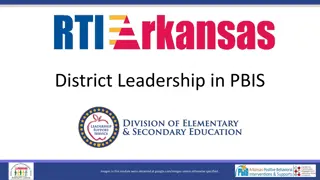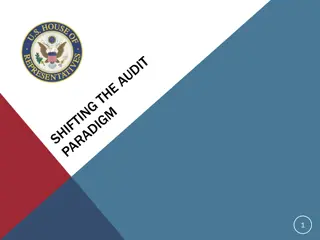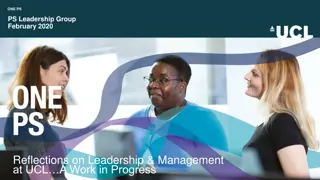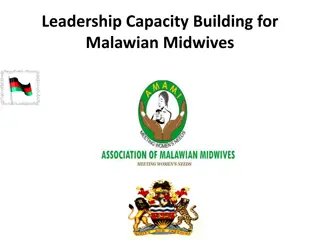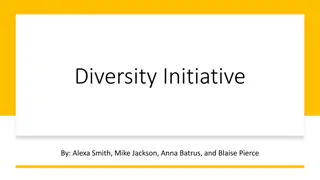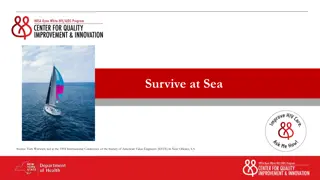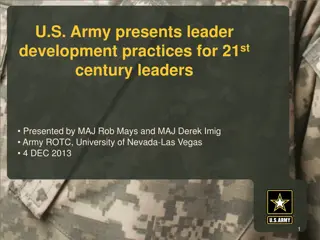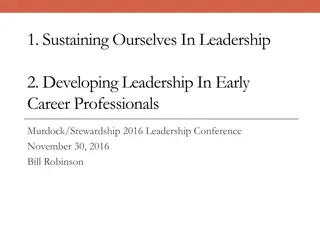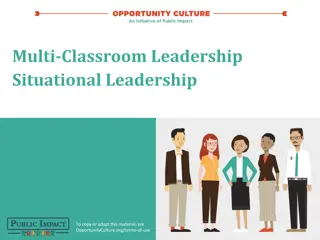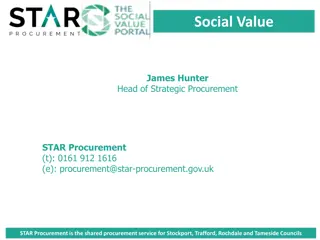Building Synergy Through Value-Based Leadership: A Guide to Problem-Solving and Team Development
Unleash the power of synergy by understanding the essence of problem-solving and value-based leadership. Learn to navigate team dynamics, identify underlying issues, and foster a culture of collaboration. Embrace self-reflection, balance, self-confidence, and humility to lead your team to success.
Download Presentation

Please find below an Image/Link to download the presentation.
The content on the website is provided AS IS for your information and personal use only. It may not be sold, licensed, or shared on other websites without obtaining consent from the author. Download presentation by click this link. If you encounter any issues during the download, it is possible that the publisher has removed the file from their server.
E N D
Presentation Transcript
Synergy and Problem Solving Building Your Team
Learning Objectives Learn how to lead your team away from political power struggle to concentrate on achieving the mission. Know how to identify underlying problems, and judge best solutions moving forward. Understand why proper recording of situations, problems, and solutions is important to the long- term growth of the team Develop the skill of turning criticism into a positive and useful tool.
Introduction It s not about whether you get knocked down. It s about whether you get back up. - Vince Lombardi
What is Synergy? The interaction of elements that, when combined, produce a total effect that is greater than the sum of the individual elements, contributions, etc. That which combines or cooperates with another or others to enhance an effect. The power of a team versus oneself.
What is Problem Solving? A process by which any question, uncertainty, or difficulty can be alleviated by understanding the underlying or root cause of a problem, and then selecting and implementing the best solution from a choice of alternative actions.
Value-Based Leadership Value-based Leadership is leading by staying true to one s values. It is the foundation of Servant Leadership. A leader must align his/her values with the organizations values. Key Qualities of Value-based Leadership: Self-reflection: a trait required for a person to identify and evaluate his/her fundamental values. Balance: a person s ability to view a situation from different perspectives. Remain open minded and consider all opinions before making a final decision. Self-confidence: is essential for leaders to truly believe in themselves. Humility: person s ability to remain grounded and keeps life in perspective. Remain humble in his/her assessment of the situation.
Value-Based Leadership Cont. The Ordeal s pledge of silence emphasizes the continuing need to spend time in thoughtful reflection. Difficult decisions will face you now and in the future, and you will need to search your heart and spirit deeply to find the resolution that will guide you onward successfully (OA Handbook page 52). What is your personal mission? The biggest obstacle to synergy is often yourself.. What is the mission of the Order of the Arrow? Look to the Obligation, Scout Oath and Law. The need for thoughtful silence. Helping the team remember our purpose.
Diversity = Team Strength Diversity is what builds teams a collection of individual experiences, backgrounds, and cultures that can view problems and challenges from a wide-variety of lenses. Diversity is about empowering people. Diversity is understanding, valuing, and using the differences in every person. It makes a team effective by capitalizing on all of the strengths of each member. Embracing diversity is the first item for building teams.
Diversity = Team Strength Cont. In the Ordeal, you worked with the help and cooperation of other candidates and members, but now you must be ready to serve without the help and cooperation of others (OA Handbook Page 53). If we both are working towards the same goal, how can we have such different points of view? Take the time to understand each other How can you, as a leader, motivate someone who disagrees with you to achieve a gain for the team? Understanding enables you to be flexible. Incorporating Ideas: A personal stake is a powerful motivator. How can those who disagree work together effectively? Developing mutual respect. A balance of give and take.
The Art of Problem Solving Jidoka: Japanese term for the art of problem solving. A method of spotting problems as they arise by stopping, analyzing, and spending time to resolve that issue so it doesn t happen again. NYLT ~ How do we eat an Elephant? One bite at a time (Very true in problem solving). Roadmap to problem solving: 1. Identify the problem 2. Identify the root causes 3. Brainstorm the solutions 4. Select the appropriate solution 5. Implement and check the impact of the solution
The Art of Problem Solving Cont. The Ordeal s test of scant food illustrates self-denial. Often you will find it necessary to abandon mere personal comfort or desires if you are to fulfill your Obligation (OA Handbook Page 53). Roadmap to problem solving: 1. Identify the problem -Are we seeing the same problems? Is there a problem at all? -The benefit of experience: ask everyone, especially your advisors or fellow advisors. 2. Identify the root causes -Chains of causation. -The links of the chain are as important as the source. 3. Brainstorm the solutions -Is it safe to disagree? The dangers of group-think. 4. Select the appropriate solution -Define the criteria that will lead to success. -Commit to the best solution before it is chosen! -Then let the team decide. 5. Implement and check the impact of the solution
Leading and Following Transparent communication: everyone s concerns and points of view are freely expressed Breakdown silos: removing hidden agendas and focus on the betterment of a healthier whole. Open minded people: working together for a common cause to making it better. A solid foundational strategy: without a strategy, change is merely substitution, not evolution. Connect the dots and map-out a realistic plan of action in advances.
Leading and Following Cont. The Ordeal s night alone focuses attention on your need for courage and self-reliance on the trail ahead. You must be willing to accept individual responsibility for your own thoughts and actions. You will find that your course will set you apart from your friends to the extent of isolation, but you must act according to your resolution regardless of what others do or fail to do (OA Handbook page 52). When should you defend the course of action you see as right when the group chooses a different path? Where do you draw the line when learning from mistakes? What right do you have to express your point of view? Good will is a complete defense. What s the proper audience for a debate? New Business = Public Old Business = Private What is your debate based on: emotion or logic? Know the facts beforehand. Don t ignore facts that point to the contrary conclusion! When to follow and when to lead. Will your choice cause a net gain or net loss? For most positions you need only consider the short-term.
Criticism Constructive: the process of offering valid and well-reasoned opinions about the work of others, usually involving both positive and negative comments, in a friendly manner rather than an oppositional one Destructive: with the intention to harm someone, derogate and destroy someone s creation, prestige, reputation and self-esteem Nothing is perfect. All things can be improved. Low self-esteem and criticism never mix. Motivation Appreciation Recognition Arrogance equals ignorance. On war and peace. Utilizing a problem generator. Unbiased mediators.
A Fuzzy Situation Form into your Lodges from Session A. With your new Lodge Adviser and Chief in place, your next step is to find why you didn t meet JTE goals. While reviewing records you notice out of 150 Brotherhood eligible Arrowmen, there was only a 10% conversion rate. Why?
Sources Value Based Leadership Website: http://www.saylor.org/site/wp- content/uploads/2013/02/BUS208-3.3.9.1-Values-Based- Leadership-FINAL.pdf The 4 Most Effective Ways Leaders Solve Problems: http://www.forbes.com/sites/glennllopis/2013/11/04/th e-4-most-effective-ways-leaders-solve-problems/ Order of the Arrow Handbook 2002 National Order of the Arrow Conference Training Syllabus
Summary Synergy/Problem Solving Value-based Leadership Diversity builds a stronger team. Criticism should be constructive to make an effective impact on the team.
Summary Cont. Roadmap to Problem Solving 1. Identify the problem 2. Identify the root causes 3. Brainstorm the solutions 4. Select the appropriate solution 5. Implement and check the impact of the solution
For Training Resources and More Information Visit: http://training.oa-bsa.org/noac2015




